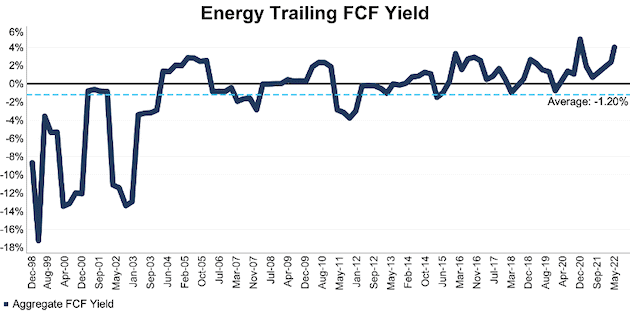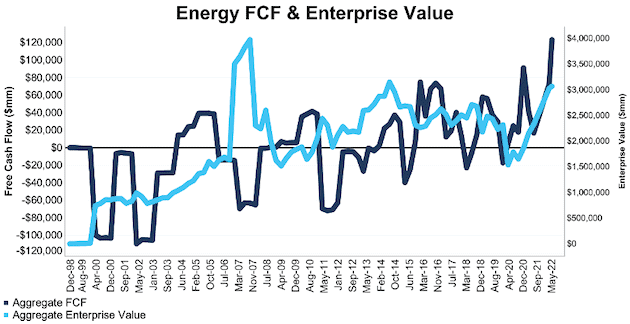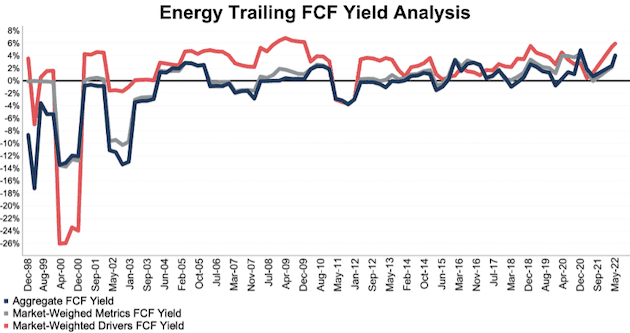The NC 2000’s trailing free cash flow (FCF) remains high, relative to recent quarters, because stock prices are declining more than FCF. We think the market is signaling expectations for further declines in FCF, and we expect prices will continue to fall until the end of FCF declines is in sight.
This report is an abridged and free version of All Cap Index & Sectors: Free Cash Flow Yield Near Record Highs Through 5/16/22, one of our quarterly reports on fundamental market and sector trends.
The full version of this report analyzes[1],[2] free cash flow, enterprise value, and the trailing FCF yield for the NC 2000 and each of its sectors (last quarter’s analysis is here). These reports are available to clients with a Pro or higher membership or can be purchased here.
This report leverages our cutting-edge Robo-Analyst technology to deliver proven-superior[3] fundamental research and support more cost-effective fulfillment of the fiduciary duty of care.
NC 2000 Trailing FCF Yield Rises Over the Last Year
The trailing FCF yield for the NC 2000 rose from 1.2% as of 6/30/21 to 1.7% as of 5/16/22. The FCF yield for the NC 2000 has been this high only two other times since 2015: 6/30/16 and 12/31/18.
See Figure 1 in the full version of our report for the chart of FCF Yield for the NC 2000 from December 1998 through 5/16/22.
Eight NC 2000 sectors saw an increase in trailing FCF yield from 6/30/21 to 5/16/22,
Key Details on Select NC 2000 Sectors
With a 4.2% FCF Yield, investors are getting more FCF for their investment dollar in the Basic Materials sector than any other sector as of 5/16/22. On the flip side, the Industrials sector, at -0.9%, currently has the lowest trailing FCF yield of all NC 2000 sectors.
The Telecom Services, Energy, Utilities, Financials, Real Estate, Healthcare, Consumer Non-cyclicals, and Basic Materials sectors each saw an increase in trailing FCF yield from 6/30/21 to 5/16/22.
Below, we highlight the Energy sector's trailing FCF yield.
The full version provides the same details for every sector as this report does for the Energy Sector.
Sample Sector Analysis: Energy
Figure 1 shows trailing FCF yield for the Energy sector rose from 0.7% as of 6/30/21 to 4.0% as of 5/16/22. The Energy sector FCF rose from $16.8 billion in 1Q21 to $123.2 billion in 1Q22, while enterprise value increased from $2.3 trillion as of 6/30/21 to $3.1 trillion as of 5/16/22.
Figure 1: Energy Trailing FCF Yield: Dec 1998 – 5/16/22
Sources: New Constructs, LLC and company filings.
The May 16, 2022 measurement period uses price data as of that date and incorporates the financial data from 1Q22 10-Qs, as this is the earliest date for which all the 1Q22 10-Qs for the NC 2000 constituents were available.
Figure 2 compares the trends in FCF and enterprise value for the Energy sector since 1998. We sum the individual NC 2000/sector constituent values for free cash flow and enterprise value. We call this approach the “Aggregate” methodology, and it matches S&P Global’s (SPGI) methodology for these calculations.
Figure 2: Energy FCF & Enterprise Value: Dec 1998 – 5/16/22
Sources: New Constructs, LLC and company filings.
The May 16, 2022 measurement period uses price data as of that date and incorporates the financial data from 1Q22 10-Qs, as this is the earliest date for which all the 1Q22 10-Qs for the NC 2000 constituents were available.
The Aggregate methodology provides a straightforward look at the entire NC 2000/sector, regardless of market cap or index weighting, and matches how S&P Global (SPGI) calculates metrics for the S&P 500.
For additional perspective, we compare the Aggregate method for free cash flow with two other market-weighted methodologies. Each method has its pros and cons, which are detailed in the Appendix.
Figure 3 compares these three methods for calculating the Energy sector’s trailing FCF yields.
Figure 3: Energy Trailing FCF Yield Methodologies Compared: Dec 1998 – 5/16/22
Sources: New Constructs, LLC and company filings.
The May 16, 2022 measurement period uses price data as of that date and incorporates the financial data from 1Q22 10-Qs, as this is the earliest date for which all the 1Q22 10-Qs for the NC 2000 constituents were available.
This article originally published on June 2, 2022.
Disclosure: David Trainer, Kyle Guske II, and Matt Shuler receive no compensation to write about any specific stock, style, or theme.
Follow us on Twitter, Facebook, LinkedIn, and StockTwits for real-time alerts on all our research.
Appendix: Analyzing Trailing FCF Yield with Different Weighting Methodologies
We derive the metrics above by summing the individual NC 2000/sector constituent values for free cash flow and enterprise value to calculate trailing FCF yield. We call this approach the “Aggregate” methodology.
The Aggregate methodology provides a straightforward look at the entire NC 2000/sector, regardless of market cap or index weighting, and matches how S&P Global (SPGI) calculates metrics for the S&P 500.
For additional perspective, we compare the Aggregate method for free cash flow with two other market-weighted methodologies. These market-weighted methodologies add more value for ratios that do not include market values, e.g. ROIC and its drivers, but we include them here, nonetheless, for comparison:
- Market-weighted metrics – calculated by market-cap-weighting the trailing FCF yield for the individual companies relative to their sector or the overall NC 2000in each period. Details:
- Company weight equals the company’s market cap divided by the market cap of the NC 2000/ its sector
- We multiply each company’s trailing FCF yield by its weight
- NC 2000/Sector trailing FCF yield equals the sum of the weighted trailing FCF yields for all the companies in NC 2000/sector
- Market-weighted drivers – calculated by market-cap-weighting the FCF and enterprise value for the individual companies in each sector in each period. Details:
- Company weight equals the company’s market cap divided by the market cap of the NC 2000/ its sector
- We multiply each company’s free cash flow and enterprise value by its weight
- We sum the weighted FCF and weighted enterprise value for each company in the NC 2000/each sector to determine each sector’s weighted FCF and weighted enterprise value
- NC 2000/Sector trailing FCF yield equals weighted NC 2000/sector FCF divided by weighted NC 2000/sector enterprise value
Each methodology has its pros and cons, as outlined below:
Aggregate method
Pros:
- A straightforward look at the entire NC 2000/sector, regardless of company size or weighting
- Matches how S&P Global calculates metrics for the S&P 500.
Cons:
- Vulnerable to impact of companies entering/exiting the group of companies, which could unduly affect aggregate values. Also susceptible to outliers in any one period.
Market-weighted metrics method
Pros:
- Accounts for a firm’s market cap relative to the NC 2000/sector and weights its metrics accordingly.
Cons:
- Vulnerable to outlier results from a single company disproportionately impacting the overall trailing FCF yield.
Market-weighted drivers method
Pros:
- Accounts for a firm’s market cap relative to the NC 2000/sector and weights its free cash flow and enterprise value accordingly.
- Mitigates the disproportionate impact of outlier results from one company on the overall results.
Cons:
- More volatile as it adds emphasis to large changes in FCF and enterprise value for heavily weighted companies.
[1] We calculate these metrics based on S&P Global’s (SPGI) methodology, which sums the individual NC 2000 constituent values for free cash flow and enterprise value before using them to calculate the metrics. We call this the “Aggregate” methodology.
[2] Our research is based on the latest audited financial data, which is the 1Q22 10-Q in most cases. Price data is as of 5/16/22.
[3] Our research utilizes our Core Earnings, a more reliable measure of profits, as proven in Core Earnings: New Data & Evidence, written by professors at Harvard Business School (HBS) & MIT Sloan and published in The Journal of Financial Economics.



